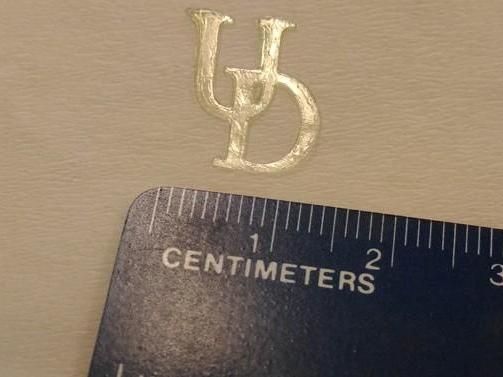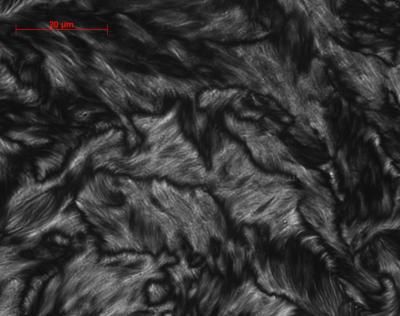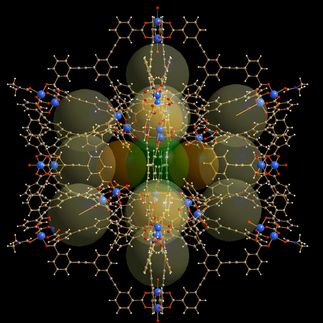Engineering on a blue streak
A pair of engineers at the University of Delaware has developed a process to form interwoven polymer networks more easily, quickly and sustainably than traditional methods allow. Their secret ingredient? Blue light.

University of Delaware researchers made the University logo using their newly developed polymerization technique.
Abhishek Shete/ University of Delaware
Abhishek Shete, graduate research assistant in materials science and engineering, and Christopher Kloxin, assistant professor in materials science and engineering and chemical and biomolecular engineering, describe their method in a paper.
Polymers, which are materials made from chains of molecules, are found in everything from food to clothing to cars. Two or more types of polymer chains with different individual properties can also be linked together to form interpenetrating polymeric networks, materials that often combine favorable mechanical properties from each polymer such as high strength and toughness.
"These chemistries independently are used in a broad range of applications," from dental composites, automobile bumpers to drug delivery materials, Shete said.
However, the process of linking polymers is not simple. It requires two chemical reactions, which are typically initiated through either a lengthy two-step process or a one-step process induced at elevated temperatures and longer time spans.
The method Kloxin and Shete developed is one step and works rapidly at room temperature and ambient conditions.
They use 470-nanometer blue light, which is similar to blue LED light used to detect certain body fluids in crime scene investigations. This light triggers reactions with a photosensitizer called camphorquinone and an activator called amine. These materials are commonly utilized in polymeric dental composites for filling cavities.
The light irradiates the materials to photostimulate the two chemical reactions, but not simultaneously. First up is a reaction called the copper-catalyzed azide-alkyne cycloaddition (CuAAC) click polymerization. This reaction is facilitated by copper, and polymerization occurs in steps. Next is a reaction called the methacrylate polymerization, which forms a plastic-like material in a manner similar to adding links to a growing chain. "This is unique in the way the blue light induces sequential reactions," says Kloxin.
The end result is a material that Kloxin and Shete describe as a "glassy film," less brittle than pure methacrylate and stronger than pure CuAAC at higher temperature. The films made from this IPN material also exhibit shape memory-- when deformed, it can be returned to its original size and shape with 15 minutes of heating at 80 degrees Celsius.
This blue-light approach to form interpenetrating polymer networks saves time and energy, but those are not its only advantages. For one, this approach allows Kloxin and Shete to control the pair of chemical reactions with increased precision, allowing them to fashion the polymer networks into complex shapes. This rapid method also keeps the ingredients from separating in a way that could otherwise interfere with the formation of an interpenetrating polymer network.
In addition, the new process requires none of the solvents or additives commonly used in plastics manufacturing, often added to prevent brittle fracture. The materials reported by Kloxin and Shete exhibit enhanced toughness that overcomes this brittleness without any solvents or additives, also making it a greener synthetic approach.
The team has filed a provisional patent for the method described in the new paper. "These chemistries could be attached to other molecules," Kloxin said, and the team will test their applications to form hydrogels, dental materials and other polymer networks.
Original publication
Other news from the department science
These products might interest you

Eclipse by Wyatt Technology
FFF-MALS system for separation and characterization of macromolecules and nanoparticles
The latest and most innovative FFF system designed for highest usability, robustness and data quality

Spinsolve Benchtop NMR by Magritek
Spinsolve Benchtop NMR
Spinsolve is a revolutionary multinuclear NMR spectrometer that provides the best performance

HYPERION II by Bruker
FT-IR and IR laser imaging (QCL) microscope for research and development
Analyze macroscopic samples with microscopic resolution (5 µm) in seconds

Get the chemical industry in your inbox
By submitting this form you agree that LUMITOS AG will send you the newsletter(s) selected above by email. Your data will not be passed on to third parties. Your data will be stored and processed in accordance with our data protection regulations. LUMITOS may contact you by email for the purpose of advertising or market and opinion surveys. You can revoke your consent at any time without giving reasons to LUMITOS AG, Ernst-Augustin-Str. 2, 12489 Berlin, Germany or by e-mail at revoke@lumitos.com with effect for the future. In addition, each email contains a link to unsubscribe from the corresponding newsletter.



























































